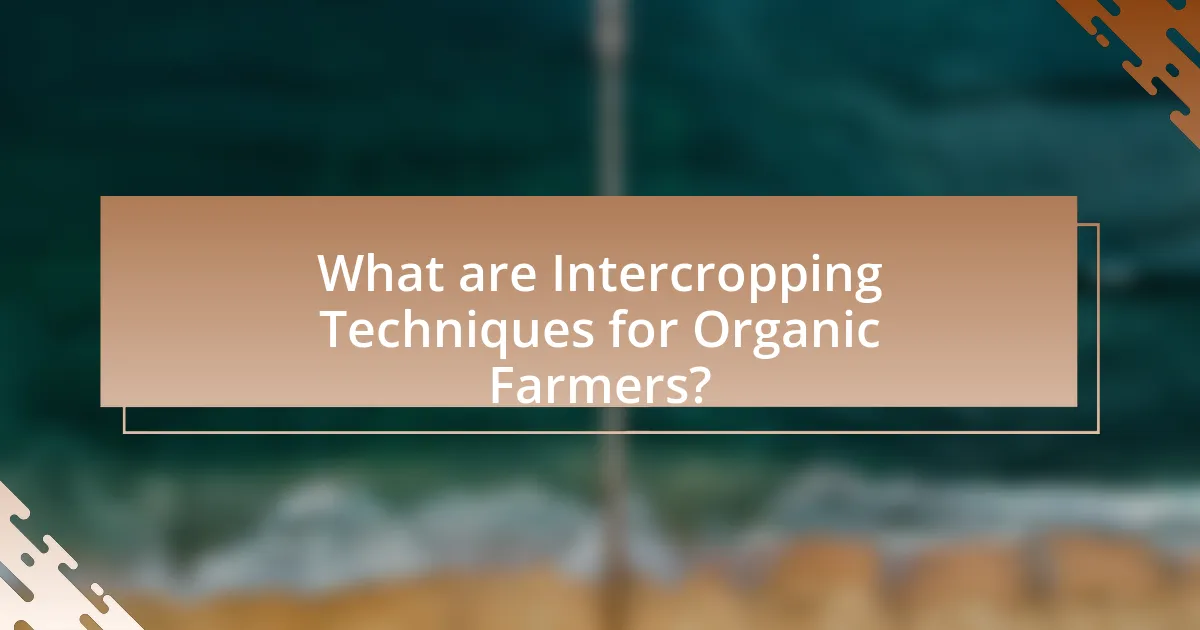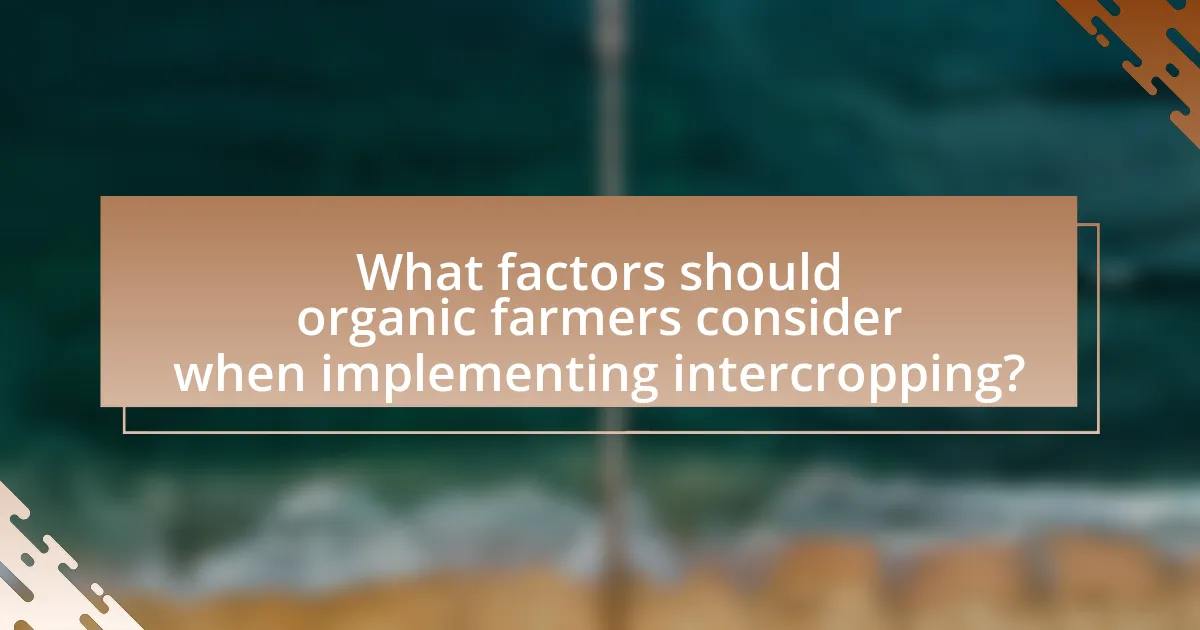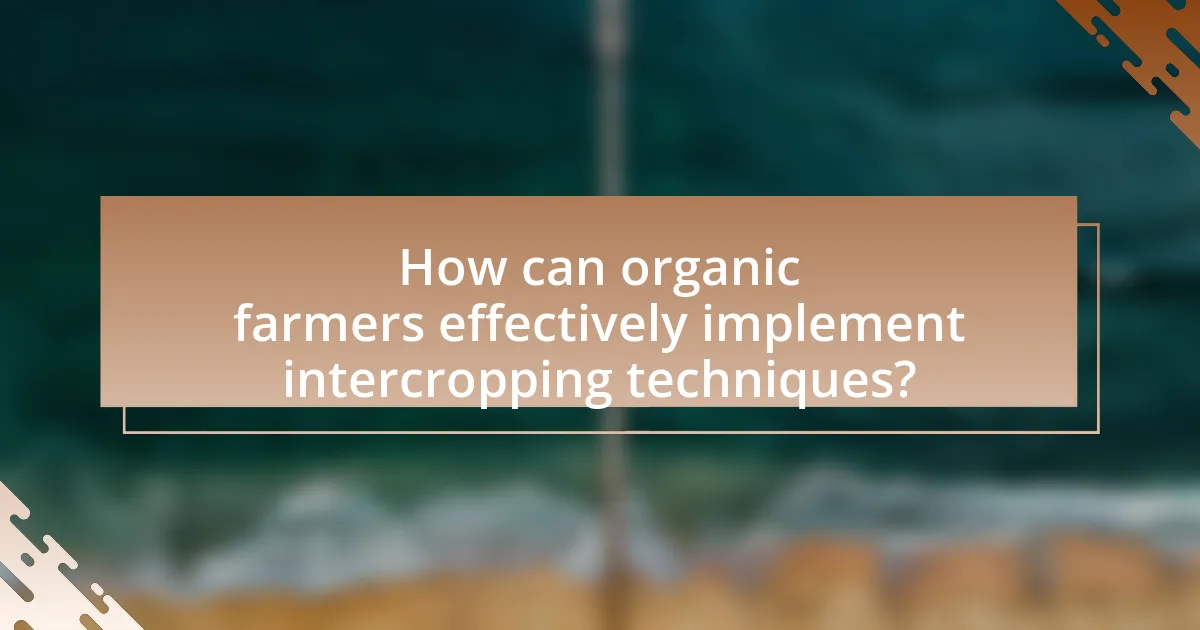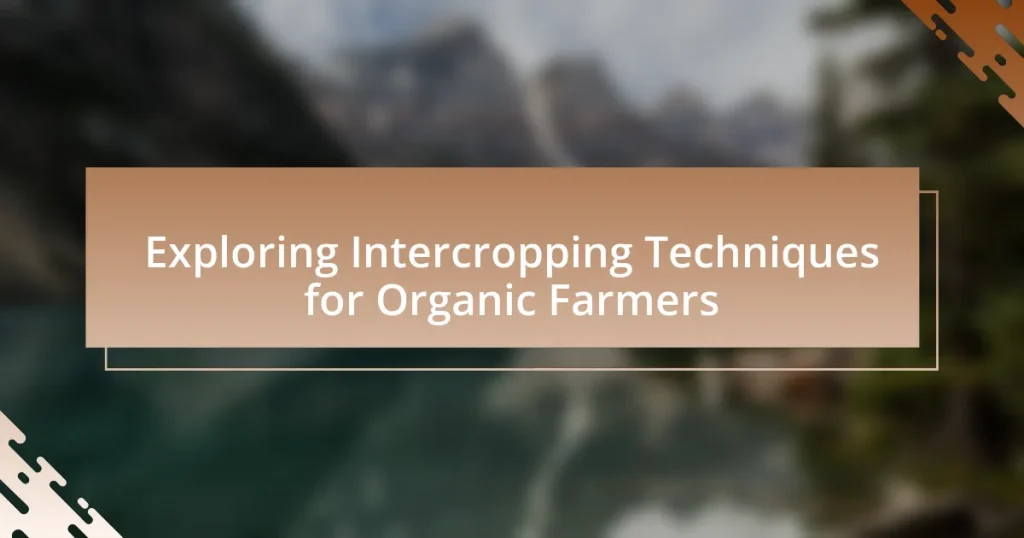The article focuses on intercropping techniques for organic farmers, which involve the simultaneous cultivation of multiple crops to enhance biodiversity and optimize resource use. Key intercropping methods discussed include row intercropping, strip intercropping, and relay intercropping, each offering distinct advantages in terms of soil health, pest management, and crop yields. The article highlights the ecological benefits of intercropping, such as improved nutrient cycling and reduced reliance on chemical inputs, while also addressing challenges like pest management and labor intensity. Additionally, it provides practical tips for successful implementation, emphasizing the importance of crop compatibility and proper spacing to maximize productivity in organic farming systems.

What are Intercropping Techniques for Organic Farmers?
Intercropping techniques for organic farmers involve the simultaneous cultivation of two or more crops in proximity to enhance biodiversity and optimize resource use. These techniques include row intercropping, where different crops are planted in alternating rows, and strip intercropping, which involves growing crops in strips to maximize sunlight and reduce pest pressure. Research indicates that intercropping can lead to improved soil health, increased yields, and reduced reliance on chemical inputs, as demonstrated in studies showing that intercropped systems can yield up to 20-30% more than monocultures due to complementary crop interactions.
How do intercropping techniques benefit organic farming?
Intercropping techniques benefit organic farming by enhancing biodiversity, improving soil health, and increasing crop yields. These practices involve growing two or more crops in proximity, which can lead to better pest management and reduced disease incidence due to the presence of diverse plant species. Research indicates that intercropping can improve nutrient utilization, as different crops may have varying root structures and nutrient requirements, leading to more efficient use of soil resources. For instance, a study published in the journal “Agronomy for Sustainable Development” found that intercropping legumes with cereals can increase overall productivity by up to 30% compared to monoculture systems. This approach not only supports sustainable farming practices but also contributes to the resilience of agricultural systems against climate variability.
What are the ecological advantages of intercropping?
Intercropping offers significant ecological advantages, including enhanced biodiversity, improved soil health, and reduced pest pressure. By planting multiple crop species together, intercropping promotes a diverse ecosystem that supports various beneficial organisms, which can lead to increased resilience against pests and diseases. Studies have shown that intercropping can improve soil structure and fertility through the complementary root systems of different plants, which can enhance nutrient uptake and reduce soil erosion. Additionally, intercropping can lead to lower pesticide use, as the diversity of crops can disrupt pest life cycles and reduce infestations, ultimately contributing to a more sustainable agricultural practice.
How does intercropping improve soil health?
Intercropping improves soil health by enhancing biodiversity and promoting nutrient cycling. This agricultural practice allows different plant species to grow together, which can lead to improved soil structure and increased organic matter. For instance, legumes in intercropping systems can fix atmospheric nitrogen, enriching the soil with this essential nutrient, thereby reducing the need for synthetic fertilizers. Research has shown that intercropping can increase soil microbial diversity, which is crucial for nutrient availability and soil resilience. Studies indicate that intercropping can lead to a 20-30% increase in soil organic carbon compared to monoculture systems, demonstrating its effectiveness in enhancing soil health.
What types of intercropping systems exist?
There are several types of intercropping systems, including row intercropping, strip intercropping, and relay intercropping. Row intercropping involves planting two or more crops in alternating rows, which can enhance resource use efficiency. Strip intercropping consists of growing crops in strips wide enough for separate management, allowing for better light and nutrient access. Relay intercropping entails planting a second crop before the first crop is harvested, maximizing land use and extending the growing season. These systems have been shown to improve biodiversity, reduce pest pressure, and increase overall yield stability in agricultural practices.
What is the difference between row intercropping and strip intercropping?
Row intercropping involves planting two or more crops in alternating rows, allowing for efficient use of space and resources, while strip intercropping consists of growing crops in wide strips, typically with each strip dedicated to a single crop. The primary distinction lies in the arrangement: row intercropping focuses on the intermixing of crops within rows, enhancing competition and resource sharing, whereas strip intercropping emphasizes distinct crop strips that can optimize sunlight and reduce pest pressure. This differentiation is supported by studies indicating that row intercropping can increase yield stability and biodiversity, while strip intercropping can improve soil health and reduce erosion.
How does relay intercropping function?
Relay intercropping functions by planting a second crop in the same field before the first crop is harvested, allowing both crops to grow simultaneously for a period. This technique maximizes land use and can enhance resource efficiency, as the second crop can utilize residual nutrients and moisture left by the first crop. Research indicates that relay intercropping can improve overall yield and reduce pest pressure, as diverse plantings can disrupt pest life cycles and promote beneficial organisms. Studies have shown that relay intercropping can increase total biomass production by up to 30% compared to monoculture systems, demonstrating its effectiveness in sustainable agriculture practices.

What factors should organic farmers consider when implementing intercropping?
Organic farmers should consider crop compatibility, resource allocation, pest management, and soil health when implementing intercropping. Crop compatibility ensures that the chosen plants can coexist without competing for nutrients, light, or space, which can enhance overall yield. Resource allocation involves understanding the water and nutrient needs of each crop to optimize growth and minimize waste. Effective pest management is crucial, as intercropping can either attract beneficial insects or create habitats for pests, influencing the overall health of the crops. Lastly, maintaining soil health is essential, as diverse root systems can improve soil structure and nutrient cycling, leading to better crop performance. These factors collectively contribute to the success of intercropping systems in organic farming.
How do crop compatibility and selection impact intercropping success?
Crop compatibility and selection significantly impact intercropping success by influencing resource utilization and pest management. Compatible crops can complement each other by sharing nutrients, light, and space, which enhances overall yield. For instance, legumes can fix nitrogen in the soil, benefiting neighboring crops that require nitrogen, thus improving soil fertility and crop productivity. Research indicates that intercropping systems can yield up to 20-30% more than monocultures due to these synergistic effects. Additionally, selecting crops that deter pests or diseases can reduce the need for chemical inputs, promoting organic farming practices. Therefore, careful selection of compatible crops is essential for maximizing the benefits of intercropping.
What criteria should be used for selecting companion crops?
Companion crops should be selected based on their ability to enhance growth, suppress pests, and improve soil health. Effective criteria include compatibility in nutrient requirements, growth habits that complement each other, and the potential for pest and disease suppression. For instance, legumes can fix nitrogen in the soil, benefiting neighboring crops that require nitrogen, while tall plants can provide shade for shorter crops, optimizing space and resources. Research indicates that intercropping can lead to increased yields by as much as 20-50% compared to monoculture systems, demonstrating the effectiveness of these criteria in practice.
How does crop rotation influence intercropping choices?
Crop rotation significantly influences intercropping choices by enhancing soil health and nutrient availability. When farmers rotate crops, they can improve soil structure and fertility, which allows for better growth conditions for subsequent intercrops. For instance, legumes in a rotation can fix nitrogen in the soil, benefiting subsequent crops that require higher nitrogen levels. Research indicates that diverse crop rotations can lead to increased yields and reduced pest pressures, making intercropping more effective. Studies show that integrating crops with complementary growth habits and nutrient needs can optimize resource use, leading to sustainable farming practices.
What are the challenges of intercropping for organic farmers?
Intercropping presents several challenges for organic farmers, primarily including pest management, nutrient competition, and labor intensity. Organic farmers often struggle with pest control because intercropping can create habitats for pests that thrive in diverse environments, complicating organic pest management strategies. Additionally, different crops may compete for the same nutrients, leading to reduced yields if not managed properly. Labor intensity increases as farmers must monitor and manage multiple crops simultaneously, which can strain resources and time. These challenges necessitate careful planning and management to ensure successful intercropping outcomes in organic farming.
How can pest management be addressed in intercropping systems?
Pest management in intercropping systems can be effectively addressed through the use of diverse plant species that enhance natural pest control. By planting complementary crops, farmers can disrupt pest life cycles and reduce pest populations, as certain plants can attract beneficial insects or repel harmful ones. Research indicates that intercropping can lead to a 30-50% reduction in pest damage compared to monoculture systems, as demonstrated in studies conducted by the University of California, Davis, which found that intercropped systems promote biodiversity and ecological balance. This approach not only minimizes the need for chemical pesticides but also supports sustainable agricultural practices.
What are the labor and resource implications of intercropping?
Intercropping generally requires more labor and resource management compared to monoculture systems. This is due to the need for careful planning, planting, and maintenance of multiple crop species simultaneously, which can increase labor costs by 20-50% as reported in agricultural studies. Additionally, resource implications include the necessity for diverse inputs such as fertilizers and water, tailored to the specific needs of each crop, which can lead to more efficient resource use but also requires more precise management practices. Research indicates that intercropping can enhance soil health and reduce pest pressure, ultimately leading to improved yields, but the initial labor and resource investment is significantly higher than traditional single-crop farming methods.

How can organic farmers effectively implement intercropping techniques?
Organic farmers can effectively implement intercropping techniques by selecting complementary crops that enhance each other’s growth and reduce pest pressure. For instance, planting legumes alongside cereals can improve soil nitrogen levels while minimizing weed competition. Research shows that intercropping can increase overall yield by up to 20% compared to monoculture systems, as demonstrated in studies conducted by the University of California, which found that diverse cropping systems lead to better resource utilization and resilience against pests. Additionally, farmers should consider crop rotation and timing to optimize the benefits of intercropping, ensuring that the growth cycles of the selected crops align for maximum efficiency.
What best practices should be followed for successful intercropping?
Successful intercropping requires careful planning and management of crop selection, spacing, and timing. Selecting complementary crops that utilize different resources, such as light, water, and nutrients, enhances productivity and reduces competition. For instance, pairing legumes with cereals can improve soil fertility through nitrogen fixation while maximizing land use efficiency.
Additionally, maintaining appropriate spacing between crops minimizes competition for resources and allows for better air circulation, reducing disease risk. Implementing crop rotation and diversifying plant species can further enhance soil health and pest management. Research indicates that intercropping can increase yields by 20-60% compared to monoculture systems, demonstrating its effectiveness in sustainable agriculture practices.
How can farmers design an effective intercropping layout?
Farmers can design an effective intercropping layout by selecting complementary crops that maximize resource use and minimize competition. For instance, planting legumes alongside cereals can enhance nitrogen fixation, benefiting both crops. Research indicates that intercropping can increase yields by 20-60% compared to monoculture systems, as demonstrated in studies conducted by the Food and Agriculture Organization. Additionally, farmers should consider factors such as crop height, growth duration, and root depth to optimize space and light availability, ensuring that each crop can thrive without hindering the others.
What tools and resources are available to assist with intercropping?
Tools and resources available to assist with intercropping include crop rotation planners, soil health assessment tools, and intercropping guides. Crop rotation planners help farmers design effective planting schedules that maximize yield and minimize pest issues. Soil health assessment tools, such as soil testing kits, provide insights into nutrient levels and soil structure, which are crucial for selecting compatible intercrops. Intercropping guides, often published by agricultural extension services or universities, offer research-based recommendations on plant pairings and management practices. These resources are validated by studies indicating that intercropping can enhance biodiversity, improve soil health, and increase overall farm productivity.
What are some common mistakes to avoid in intercropping?
Common mistakes to avoid in intercropping include poor crop selection, inadequate spacing, and neglecting nutrient requirements. Poor crop selection can lead to competition for resources, reducing yields; for example, pairing crops with similar nutrient needs can deplete soil fertility. Inadequate spacing may result in overcrowding, which stifles growth and increases disease risk. Neglecting nutrient requirements can cause deficiencies, as different crops have varying nutrient demands, leading to suboptimal growth and yield. These mistakes can significantly hinder the effectiveness of intercropping systems, as evidenced by studies showing that proper planning and management can enhance biodiversity and productivity in organic farming.
How can improper spacing affect crop yields?
Improper spacing can significantly reduce crop yields by limiting access to essential resources such as sunlight, water, and nutrients. When crops are planted too closely together, competition increases, leading to stunted growth and lower overall productivity. Research indicates that optimal spacing can enhance light penetration and air circulation, which are crucial for photosynthesis and plant health. For example, a study published in the “Journal of Agricultural Science” found that maize yields decreased by up to 30% when planted at inadequate spacing compared to recommended distances. This evidence underscores the importance of proper spacing in maximizing crop yields.
What role does monitoring and adjustment play in intercropping success?
Monitoring and adjustment are critical for intercropping success as they enable farmers to optimize crop performance and resource use. By regularly assessing plant health, soil conditions, and pest populations, farmers can make informed decisions to enhance the growth of complementary crops. For instance, studies have shown that timely adjustments in planting density and nutrient management can lead to yield increases of up to 30% in intercropped systems. This proactive approach allows for the identification of potential issues early, ensuring that crops can thrive together rather than compete for resources.
What practical tips can enhance intercropping outcomes for organic farmers?
To enhance intercropping outcomes for organic farmers, implementing crop diversity and selecting complementary species is essential. Diverse crops can improve soil health, reduce pest pressure, and increase overall yield. For instance, planting legumes alongside cereals can enhance nitrogen fixation, benefiting both crops. Additionally, utilizing crop rotation and cover crops can further improve soil structure and fertility, leading to better intercropping results. Research indicates that intercropping can increase yields by 20-50% compared to monoculture systems, demonstrating its effectiveness in sustainable agriculture.










